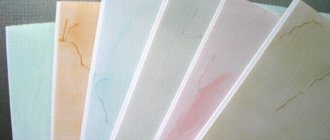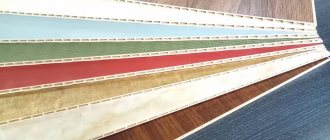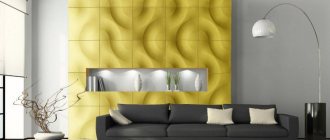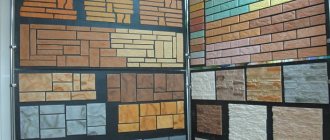How to properly glue PVC sheet panels in the bathroom (wall preparation, glue, installation)?
5 We are considering the option of covering the walls with PVC sheet panels in the bathroom. Interested in the following advice from professionals:
the author of the question chose this answer as the best 3 The most important thing is to prepare the wall, because moisture collects in the bathroom, and the sheet panels are not glued tightly to the wall, so it is necessary to treat the wall with waterproofing material, depending on the wall material. My favorite is cement-based waterproofing material; it is applied directly over the plaster. So, what is needed to install such panels:
So let’s move on to the installation steps in detail, there will be 5 of them, between which you can have a smoke break: |
Installation and Installation
A decorative panel will help hide the imperfections of the walls; with its help it is possible to hide even significant flaws. Still, uneven walls, holes and bulges can cause material to peel off. Before gluing it, it is better to choose an adhesive suitable for the plastic and carefully prepare the walls. Installation of the material is carried out in two ways, they are described below.
Gluing order
Gluing mosaics to the wall is the simplest and most popular solution. The surface must be plastered, leveled, and primed. Large differences will lead to swelling of thin plastic, so all irregularities must be eliminated using putty.
The gluing procedure is as follows:
- keep the material at room temperature for 12 hours or more,
- drop any degreaser onto the plastic, wipe it off,
- apply glue pointwise around the entire perimeter and in the center,
- lean the sheet against the wall according to the markings,
- press and hold for the required time (according to the instructions for the specific adhesive composition).
Liquid nails, polyurethane or silicone glue are suitable for installation. Since gaps inevitably appear between individual elements, silicone sealant is used to hide them. For the same purpose, you can use a special molding. It is possible to cut the mosaic using strong scissors or a construction knife.
Installation on the sheathing
If the wall is too uneven, it is not possible to put it in order; another method of installing the panels is allowed. To do this, you need to make a sheathing from wooden blocks, treating them with a fungicide against mold. The distance between individual bars is 50 cm; the sheathing is attached to the wall with nails and dowels. Then you can glue the mosaic in the same way.
In the free space between the sheathing and the wall, you can hide wires, lay insulation, etc. Caring for plastic panels is easy. They can be washed and wiped with a damp cloth without fear of spoiling them.
Choosing materials for finishing the bathroom: pros and cons
Let's look at what material to choose under different conditions. After all, a bathroom in a Khrushchev-era building and in a private house may differ in many ways. Which greatly influence the choice of source materials.
Plastic panels
Finishing with PVC panels is a very economical option. And not only in finances, but also in energy costs.
They are very clear and easy to install, they are lightweight, and have a huge number of colors and textures.
They are easy to clean and are not afraid of water. They perform well even in very damp areas.
Finishing the bathroom with plastic panels
If the owners want to change the interior, the panels can be easily dismantled and replaced. It is also easy to cut a hole in the panel for the counter shutter.
But this type of material has disadvantages. For example, this is their speed of melting and ease of ignition in a fire. Therefore, during repairs, you need to check the wiring in the entire apartment and, before installing the panels, replace all areas that raise doubts.
Another disadvantage can be considered the fact that the panels are attached using a frame method, usually on bars. It eats up space. Of course, if you have a 6 square meter bathroom, you may not notice much of a difference. And for owners of Khrushchev apartments, losing these few centimeters is very sensitive.
PVC panels begin to turn yellow during use and may lose their original freshness and appearance.
There is another important point that plastic panels do not “breathe”, which is why after a couple of years mold may appear between it and the frame on the wall where moisture gets in. Therefore, before starting work, when the walls are cleared of old coating and leveled, it is advisable to treat them with antifungal mixtures.
Ceramic tile
A classic option for finishing bathrooms. It always looks neat, reliable and impressive. Especially if you choose colors that are companions.
Tile finishing is durable and reliable, does not provoke mold. The tiles are easy to care for and do not lose their elegant original appearance for quite a long time.
Bathroom tiling
It costs more than panels, and weighs more. If you decide to lay it yourself, then you need to look at the information on the correct laying of tiles so as not to be disappointed with the result.
Of course, this finishing method is quite energy-intensive and is carried out in several stages. This is a wonderful option for both spacious rooms and bathrooms with limited space, because... practically does not eat living centimeters.
You can create different patterns from tiles. Just a splash of another color, like accents. So is the assembly of entire wall panels depicting landscapes, nature, animals and other drawings.
There is also a combined option. When one part of the bathtub is decorated with tiles, and the second with panels. This is how some kind of zoning occurs. Most often this is done in combined bathrooms.
Combination of materials
Photos of designs with bathroom finishing with plastic panels and tiles
There are a lot of design ideas. And the entire harmony of finishing arises from the correct combination of colors. The photo shows tile finishing in a deep green color, which has a calming effect. The tiles envelop both the walls and the frame of the bathtub, which creates a single ensemble that is pleasing to the eye.
A non-standard combination of several types of tiles with an emphasis on decorative mosaic wood. In this case, the ceiling is also tiled.
The photo shows a safari style design. An interesting option, the main thing is not to overdo it with colorful elements.
Tiling
Refreshing light design with an emphasis on mirror mosaic. A very self-sufficient option.
The theme of nature is emphasized in the design with wood-effect panels and a harmonious color scheme.
Quite a strict finishing option. Vertical stripes of brown tiles give a clear graphic appearance.
Bathroom design option with inserted tiles with a pattern. One of the classic and everyone’s favorite options for combining colors and creating accents.
The photo focuses on the bathroom area. It looks very fresh and interesting.
The photo shows the design of a large room with a combination of two colors. Thanks to more white tiles, the interior does not look heavy or dark.
Ideas for decorating bathrooms in Khrushchev 4 sq.m.
When you have very limited space, it is difficult to expand in design, but it is possible! Of course, the Khrushchev buildings suffer from their size, but they have bathrooms in the shape of a regular rectangle or square, if it is a combined bathroom.
Finishing a bathroom in Khrushchev
You can increase the usable area using a countertop that is made of the same type of tile as the wall. Such a smooth transition is pleasing to the eye. The bath area is separated from the rest of the room by another type of tile, which creates a small zoning of the room.
Finishing a bathroom in Khrushchev
Laconic gray shades look strict but stylish. In such a bath you want to relax and get away from everything unnecessary. The tiles are selected in the same color, but in different shades. on the walls it is lighter and this makes them lighter.
The photo shows an interesting combination of two color schemes in tiles. Functional areas that are easily dirty are clearly highlighted in dark, but the design is lightened by interspersed white tiles.
If you want brightness, then an interesting option is with a full-wall panel. A standard bath of 4 square meters becomes unusual and non-standard.
A mosaic-shaped strip of tiles allows you to visually expand the space.
I think that these photos will encourage you to create a one and only masterpiece in your apartment.
Tips for decorating your bathroom yourself
There are many nuances in finishing any type of material.
The first step is always to remove the old coating. Then comes the alignment of the walls, floor and ceiling.
If this is not done, then all this curvature will ruin not only the appearance, but will also last a short time. For example, tiles may simply fall off and panels may crack.
The drawing and all the holes (lamps, sockets) are planned in advance on the drawing.
When choosing material in a store, you need to carefully check the samples given out.
DIY bathroom decoration
When choosing plastic panels, you need to pay attention to the following nuances:
- Matching color and pattern. There are panels that are almost identical, but from different manufacturers. As a result, the lock may not fit during installation or the shade may differ in local lighting. Therefore, we carefully look at the markings on each panel. If you don’t need a lot of material, then you can select all the panels yourself and ask the seller to pack them. This way you will be sure that they are free of defects and cracks, of the same color and manufacturer.
- Panels with a horizontal pattern are difficult to join at right angles. Keep this in mind too. Modern PVC panels come with imitation tiles, they look chic, but all imaginary tile seams must be located under a clear perpendicular. This is exactly what is difficult to achieve in panels with large patterns.
We make the lathing perpendicular to the fastening of the panel, after about 70 cm. And they can be attached either with self-tapping screws or with glue.
There are craftsmen who attach panels without a frame, but for this there must be perfectly smooth walls.
If you have already chosen tiles, then horizontal classic masonry looks more aesthetically pleasing.
This is when the wall is measured, the first row is laid without glue, and if it turns out that all of the outer tiles do not fit, then one row is removed, everything is moved to the center, and the tiles along the edges are cut off. It turns out that there are no centimeter additions that spoil the look and look very cheap. And the tiles visually look very smooth.
The optimal method for laying tiles
Therefore, they say that you need to lay the tiles from the center. Any deviation from a clear perpendicular is easily adjusted using crosses.
For a bathtub, it is better not to choose glossy black or dark tiles.
Of course, such a bathroom looks luxurious and stylish, but it causes a lot of trouble when cleaning and in everyday life. You can see all the stains and drops on it. And, if your family is not accustomed to sterile cleanliness, then such a finish will burn your nerves.
I think that these tips will help you make the right choice of material when decorating your bathroom.
Share on FB Tweet Tell VK Click Class
Varieties and characteristics
It is customary to distinguish the following types of plastic panels:
- Panels of typesetting type. They are a narrow lining. The length of such material can reach up to 3 meters, width - up to 60 cm.
- Mosaic panels. This coating consists of rectangular or square sheets with a relief mosaic pattern applied on top.
- Tiles. In this case, the coating has the shape of rectangular or square slabs. The dimensions of the latter can range from 30x30 to 100x100 cm.
In most cases, mosaic PVC panels are produced in the 955x480 cm format. Their coating can be either glossy or matte, and all of them can be easily leveled using a tile lining.
Initially, the production of such panels for interior decoration was quite expensive. And the panels themselves were too heavy, which made it impossible to use them for interior decoration. But with the advent of the free foaming method of polyvinyl chloride, it was possible to produce a lightweight and relatively affordable material.
The resulting panels have the following characteristics:
- Fire resistance. The ignition temperature of the described panels is more than 500 degrees.
- Plastic does not absorb or allow moisture to pass through. Due to the use of sealants, liquid penetration is excluded even in the seams between sheets.
- The cellular structure of mosaic panels protects the room from extraneous sounds. This material is often used in public institutions, cafes and other places with high noise levels.
- PVC panels are not subject to mechanical damage, so there is no need to worry about scratches or cracks.
- Mosaic panels bend well. From them you can create structures of any complexity. Plus, if necessary, the panel can be easily sawed, drilled, milled or cut out a shaped contour. We recommend paying attention to the Leroy mosaic.
- Thanks to the use of polymer materials, such boards are not subject to rotting and have an unlimited service life.
- This coating does not contain hazardous chemical compounds and heavy metals, so it can be used in any residential premises.
Sheet panels (PVC mosaic): instructions for gluing
Sheet panels (PVC mosaic): instructions for gluing 10 Jan
In this article we will talk about sheet decorative PVC wall panels that imitate ceramic mosaics. These are high-quality panels made using modern German technologies. For the production of such panels, PVC plastic is used, which is a strong, durable, moisture-resistant and non-flammable material. The thickness of the panels is 0.4 mm.
The panels are used for interior decoration of premises, living rooms, loggias and balconies. To transform the interior, it is enough to paste over one wall or even a fragment.
Use of sheet panels
Panels in the interior
Sheet panels are easy to care for: resistant to moisture and easy to clean. They have a wide selection of shapes and colors, which helps transform any interior at minimal cost.
Necessary tools for gluing
• Sheet panels in the required quantity; • Scotch; • Knife, scissors; • Ruler, level; • Universal edging 1 m long, which is used to decorate the surface to be pasted; • Glue
Progress
Before starting work, it is necessary to clean the walls from dirt and dust, otherwise the sheet panels will not adhere well. In this case, it is not at all necessary to achieve a perfectly flat surface, since the sheet panels themselves will hide all the imperfections. It is necessary to glue the edging along the edge of the working surface. On a horizontal surface, the edging is glued using a level, and on a vertical surface - using a plumb line.
Edging and joining profile
When installing mosaics, the main requirement is even gluing. To do this, it is better to stretch the thread from the right to the left edge and secure it to the wall with tape.
Cutting panels to size
The glue must not be applied completely to the entire sheet, but only to its protruding parts. A minute after applying the glue, the sheets must be glued to the thread. To simplify the work, it is better to start pasting the wall from the top edge from the ceiling, while securing the sheets with masking tape to the wall. To match the pattern of the second row of sheets, you need to rotate them 180 and do all the steps with the thread again.
Applying glue to panels
Thus, it is not at all necessary to have special skills to work with sheet panels; the main thing is to adhere to the basic rules, by observing which you will be able to create a bright and modern design.
| Installation of PVC sheet panels (Mosaic) |
Popular posts
- Chair for dressing table Chairs for dressing tables in Moscow - 189 Products Company from Moscow, delivery 29643 a In…
- Silicone sanitary sealant Silicone sanitary sealant white in Moscow - 1491 products Company from Moscow, delivery (tomorrow) 140...
- Shelf in the hallway Currently, there are a huge number of different options for shelves in the hallway, and this is directly ...
- Mosaic on the wall From this article you will learn the pros and cons of mosaics, its main types and materials, from…
Types of mosaic panels
Sheet panels differ not only in appearance, but also in size. Here are the main types:
- Narrow typesetting. They have connecting locks, reminiscent of lining. The length is 2.10-3 m, the width varies from 25 to 50 cm.
- Sheets, or rectangular wall slabs. Their size is 485*960 mm, but there are other formats, including for individual order.
- Square. The side of such a mosaic is 30-100 cm.
The outer coating of this finishing material can be glossy or matte. Another difference between the products is their price. Domestic manufacturers produce economy-segment panels, but there are more expensive ones. Foreign companies present similar products at high prices. The best brands are:
- PlastDecor is the largest manufacturer of construction products made from foamed polyvinyl chloride, which produces mosaics using modern equipment. Products of this brand are available in most specialized stores.
- Decoplast is an equally well-known manufacturer that constantly produces the latest types of PVC products. All products have certificates and are of very high quality.











